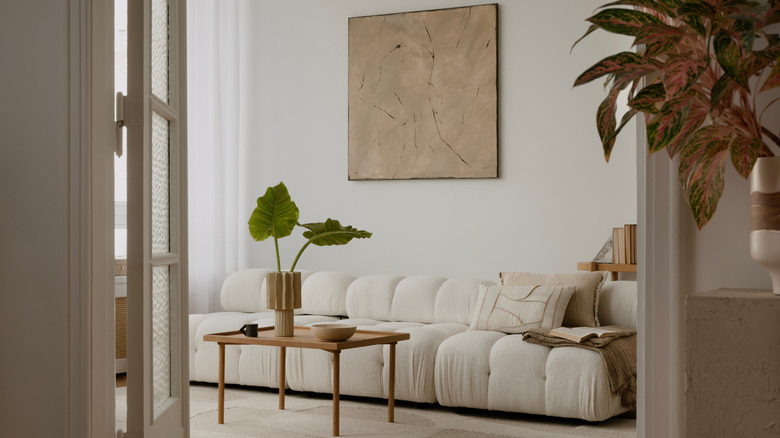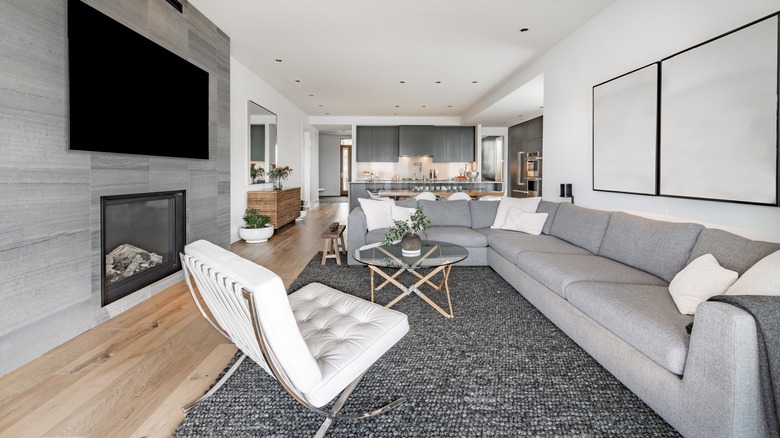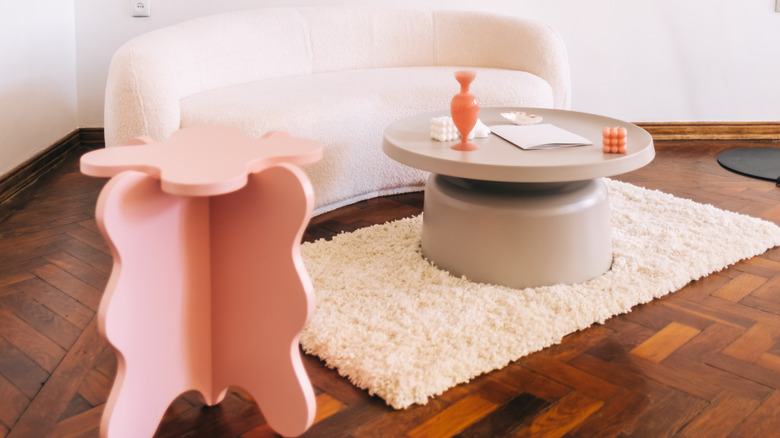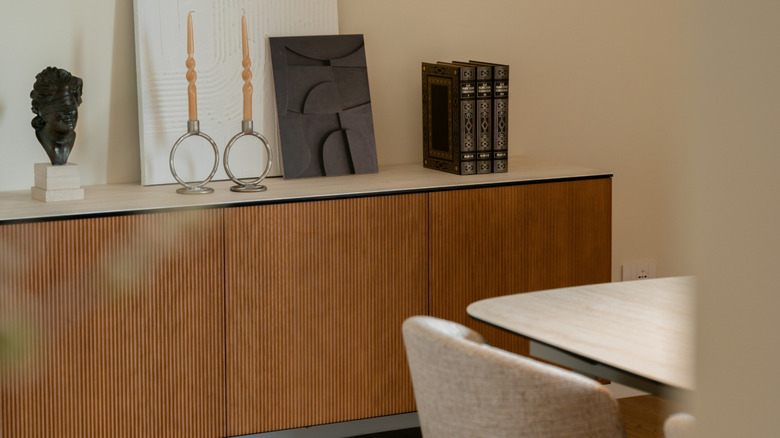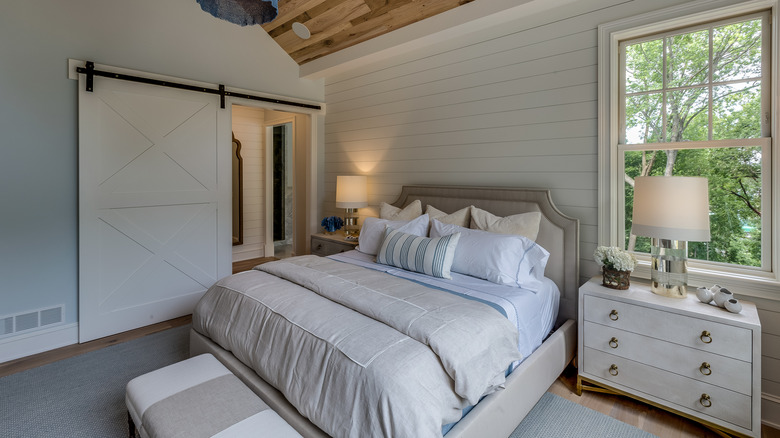Furniture Trends We're Leaving Behind In 2025
The new year often brings a fresh pair of eyes and an urge to redecorate. While 2025 was the year of earth tones, maximalism, customization, biophilic design, dark wood, and curved furniture, not all of these trends will stand the test of time to evolve from social media craze to timeless design.
Repetition, as always, is the main culprit in transforming certain styles from beloved to uninspired. It's a natural result of the now common cycle of social media algorithms filling feeds with the same popular trend. Design and lifestyle influencers eagerly join in, and, ultimately, big box stores adjust their catalogs to cater to the demand. The victims are usually the overly kitschy or specific aesthetics that either tire the eye easily, as in the case of the wavy decor home design trend, or become boring fast, like bouclé furniture.
Yet the process has been somewhat slower and more organic for some of the other furniture trends on this list. For years now, designers have been ushering in the death of the minimalist, all-gray moodboards that defined the 2010s, in favor of homes that feel personalized, lived-in, and warm. As 2026 draws nearer, this tendency will continue, and any color combo or design style that feels lifeless and bland is getting left behind.
All grays, whites, and beiges
The avalanche of soft grays, whites, and beiges in interior design was largely driven by millennials as a reaction to the stuffy, orangey brown, pattern-clad homes of their parents and grandparents. For years, this soft, monotone color scheme was seen as the paragon of sophistication and modernity, but now the trend meter has come full circle. The new generation is rejecting stark modernity and embracing tradition by inviting color and personality back to furniture, whether that's a combination of earthy greens and browns, or bold reds, pinks, and yellows.
Overly coordinated
With greige tone-on-tone interiors definitively ousted, it's only natural that matchy-matchy, uber-coordinated furniture sets are following suit. Interior design trends for 2026 are an exercise in variety and contrast. Think a couple of couches in different materials and colors, bed frames and bedside tables that don't match, or dining tables and chairs in different wood tones, as opposed to the combined pairs that look straight out of a showroom or catalog. A home feels all the warmer and cozier the more layered and collected it looks. It's okay if furniture doesn't match. It's encouraged, even.
Minimalism
It dominated furniture design for much of the 21st century, but minimalism is the "less is more" room style that's being replaced in 2026. Overly clean or understated lines may come with a promise of flexibility and harmony, thus making the task of decorating a given space easier. However, they also run the risk of becoming boring, fast. Much like the innocuous grays, beiges, and whites that this design philosophy is often associated with, the lack of detail and character in minimalist furniture is no longer as attractive as it once was. Now, people are craving visible signs of craftsmanship and pieces that look unique.
Curvy, wavy, and scalloped
Colorful, curved furniture emerged in recent years as a way to make modern homes more comfortable and quirky. Softening the edges of sofas, tables, and dressers offered a cocooning, calming atmosphere, while the peppy colors functioned as a quirky nod to the '70s. As with most trends born and popularized on social media, however, it was taken to an extreme. Soon enough, the sight of a pink wavy silhouette had become hackneyed and corny. While it still has a place as a way to provide contrast from traditional furniture, it is best used sparingly.
Bouclé
The hegemony of bouclé came hand-in-hand with the curved furniture trend — its soft, fluffy appearance a perfect match for the en-vogue round shapes. Just like the silhouette that complemented it, bouclé was overused. Every ottoman and armchair was suddenly made from this nubby fabric, and oversaturation was simply unavoidable. Designers are predicting bouclé's replacement in 2026 with mohair, velvet, and woven knits in deep, rich hues, as well as interesting prints like paisley, herringbone, and plaid. As cozy as this material looks, it's time for a change.
Fluted
Fluted furniture was all the rage from 2022 to 2024, with endless TikTok videos teaching netizens how to DIY the trendy ribbed look for their furniture with everything from corrugated cardboard to wooden dowels. It was loved for its modern-meets-classic appearance and its ability to bring subtle texture to minimalist interiors. However, the hype train started to lose steam in 2025 and is predicted to finally come to a halt by 2026. As it turns out, you can actually have too much of a good thing, because this once-chic finish is now feeling a little repetitive.
Farmhouse
Modern farmhouse, the iconic Joanna Gaines style, is officially past its prime in 2025. Although numerous elements of this aesthetic will always be timeless, such as its fondness for linens, wools, and other natural materials, the complete package, shiplap and all, is rapidly becoming outdated. Its demure, neutral minimalism is getting replaced with a more traditional, rustic approach that embraces upholstery in moodier colors and soulful patterns and woods in darker stains. As interior designer Peggy Haddad told Real Simple, "Farmhouse isn't gone, it's grown up ... Think European cottage: more color, more character, less shiplap."
Oversized
The oversized couch was one of the defining furniture pieces of the minimalist, millennial gray era, pairing perfectly with a larger-than-life TV and the accompanying Netflix binges. Its exaggerated scale and sink-in cushions in muted grays or light neutrals were the epitome of quiet luxury, and, since minimalism calls for rooms to look practically empty, it didn't matter that a single piece of furniture took up most of the square footage. Current trends are more interested in spaces that feel layered, varied, and full, which means plenty of different, contrasting furniture exists harmoniously within the space. So, yes, 2026 is officially putting the "over" in oversized sofa.
